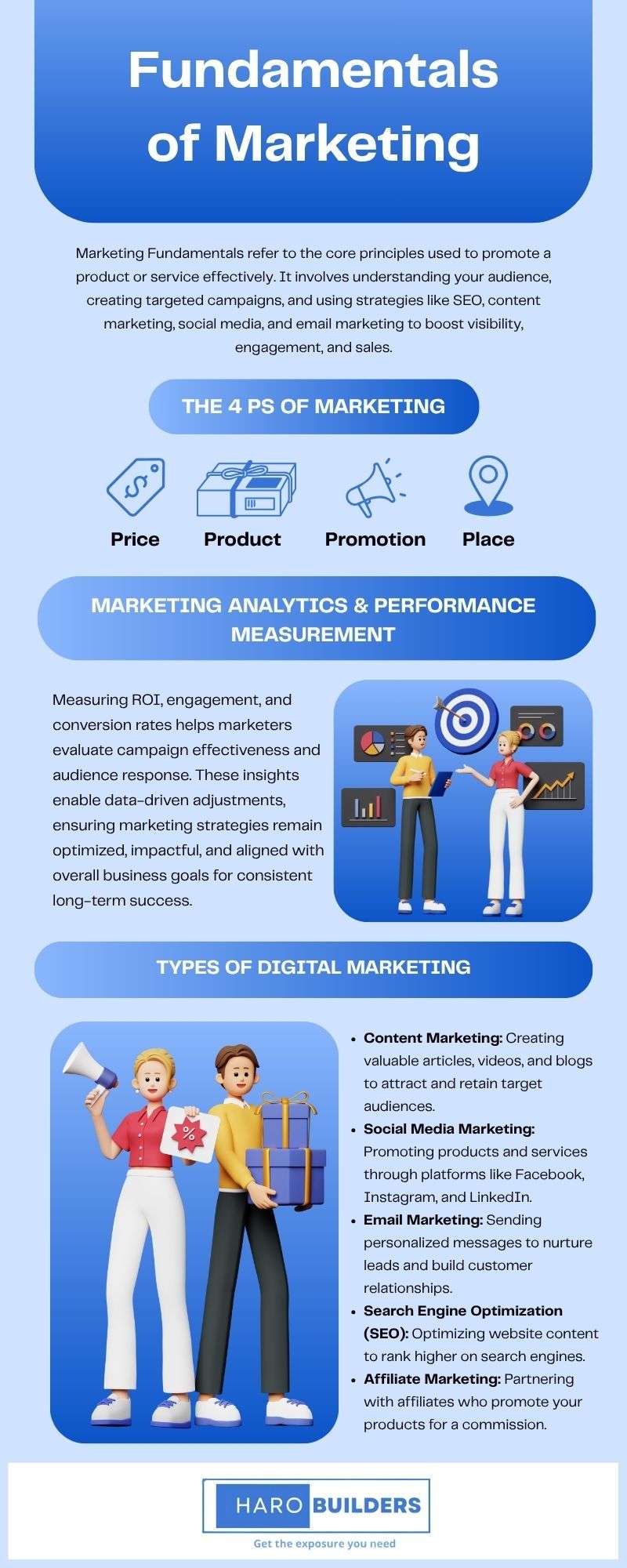
Many businesses fail to connect with their audience because they lack strong marketing fundamentals that drive consistent growth. Marketers often miss essential frameworks needed for effective customer engagement and measurable success. Marketing refers to a structured process involving planning, execution, and continuous improvement. However, applying the 7 Ps of marketing helps brands enhance visibility, strengthen credibility, and build lasting customer relationships.
The 7 Ps of Marketing include:
- Product
- Price
- Place
- Promotion
- People
- Process
- Physical Evidence
The complete guide below explains how marketing encompasses different types of marketing, including affiliate marketing, influencer marketing campaigns, and marketing automation, to help you improve your marketing strategy effectively.
Fundamentals of Marketing: A Visual Guide

Marketing Fundamentals: The 7 Ps of Marketing
Marketing fundamentals focus on structured strategies to promote a product or service effectively while achieving measurable ROI and business goals. Through digital marketing techniques like content marketing, social media marketing, email marketing, and SEO, brands enhance engagement and website traffic. The “Marketing Mix”, originally 4 Ps (Product, Price, Promotion, and Place), later expanded to seven elements to suit modern marketing, customer experience, and credibility.
Altogether, the 7 Ps framework serves as the foundation for successful marketing campaigns that attract and convert potential customers through a strategic marketing funnel.
- Product: A product or service must provide value that resonates with customer needs and expectations. Marketers must identify what differentiates their offering from competitors and highlight its unique features accordingly. Furthermore, successful marketing involves continuous market research to improve products and services and maintain relevance with changing market trends. When developing a product, marketers should ensure that design, quality, and usability meet customer satisfaction standards effectively.
- Price: It directly impacts how customers perceive a product’s worth and influences conversion rates. Hence, marketers should perform comparative analysis to assess competitors’ pricing and understand perceived value. Additionally, pricing strategies should align with marketing objectives, business goals, and ROI expectations. Promotional discounts may attract buyers, but marketers must balance them with profitability to sustain long-term growth.
- Promotion: Consists of marketing activities designed to inform, persuade, and remind customers about a brand. This includes email marketing, content marketing, social media marketing, and influencer marketing. Moreover, marketers should select marketing channels that align with audience demographics and behaviors. Effective campaigns should deliver engaging content that promotes their products and encourages customer loyalty while optimizing reach through search engine visibility.
- Place: Defines how and where a product or service becomes available to consumers. Marketers should choose distribution channels strategically, whether through retail, online platforms, or direct sales. Additionally, integrating traditional marketing with digital marketing ensures broader coverage and accessibility. Businesses must ensure that logistics, delivery, and availability are optimized to create a seamless customer experience across all touchpoints.
- People: Plays a significant role in shaping the overall customer experience and building trust. Every marketer should train employees, sales representatives, and customer service teams to uphold brand values. Furthermore, the effectiveness of marketing efforts depends on communication, empathy, and professionalism shown during every interaction. Staff who provide value-driven support contribute positively to the brand’s reputation and customer retention.
- Process: It refers to the steps involved in delivering products and services efficiently and consistently. Businesses should streamline operations using automation tools like CRM software and analytics software to monitor key performance indicators. Besides improving workflow, efficient processes reduce delays and improve conversion rates. Therefore, marketers should continuously optimize procedures to ensure reliability, quality assurance, and customer satisfaction throughout their marketing programs.
- Physical Evidence: It comprises the tangible elements that demonstrate a brand’s credibility and existence. This includes website design, product packaging, store layout, promotional materials, and brand aesthetics. In digital marketing, elements like testimonials, social proof, and consistent branding across online platforms help build customer trust. Furthermore, marketers should maintain visual consistency across all marketing channels to reinforce authenticity and strengthen brand identity.
Integrating the 7 Ps Into a Unified Marketing Strategy
| The 7 Ps | Marketing Strategy |
| Product | Marketing refers to creating and promoting a product or service you’re offering that provides value to consumers. Marketers should ensure that the value of the product meets expectations and reflects its unique benefits. |
| Price | The four Ps of marketing emphasize pricing based on how much consumers are willing to pay. A balanced pricing strategy should reflect market demand, perceived value, and ROI. |
| Place | The marketing plan should define how to reach your target audience effectively across multiple channels. Digital platforms help promote products or services and reach a global audience efficiently. |
| Promotion | Digital marketing offers opportunities to connect with your audience through influencer marketing campaigns, email marketing, and event marketing initiatives. Each channel should align with campaign goals and consumer behavior. |
| People | Every marketer must focus on staff and customer interactions since these shape brand trust and satisfaction. |
| Process | Businesses can improve your marketing by using tools like Google Analytics and marketing automation to optimize workflows and campaigns. |
| Physical Evidence | Consistent design, branding, and digital presence in the digital marketing space provide assurance and strengthen credibility for potential buyers. |
Keeping Your Marketing Approach Up-to-Date
“The moment you stop learning in marketing is the moment your strategy stops growing.”
Marketers must remain up-to-date with the latest methods to stay competitive in the digital marketing space. Using tools like Google Analytics, automation platforms, and performance metrics helps track campaign success and optimize strategies effectively.
Marketing is no longer about what you make, but about the stories you tell.” – Seth Godin
Furthermore, digital marketing offers numerous ways to connect with your audience through content like social media posts, blogs, and personalized emails. Businesses that adapt to new marketing trends and choose the right marketing channels can consistently promote their products and services while improving engagement and ROI.
Marketing is no longer about what you make, but about the stories you tell.” – Seth Godin
To gain deeper insights into online promotion and its effective use, check out our detailed guide on digital marketing basics.



